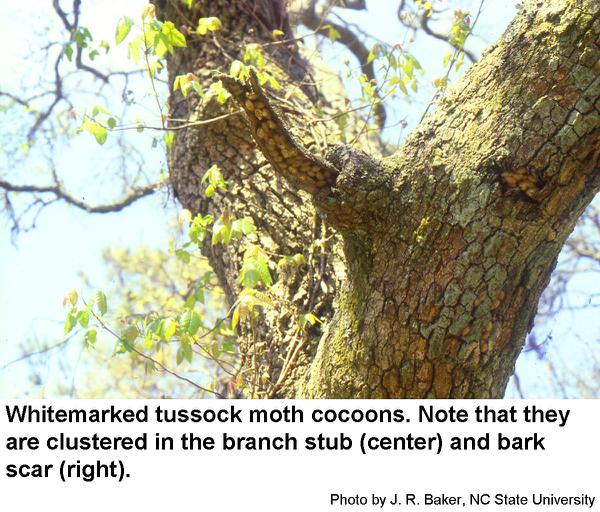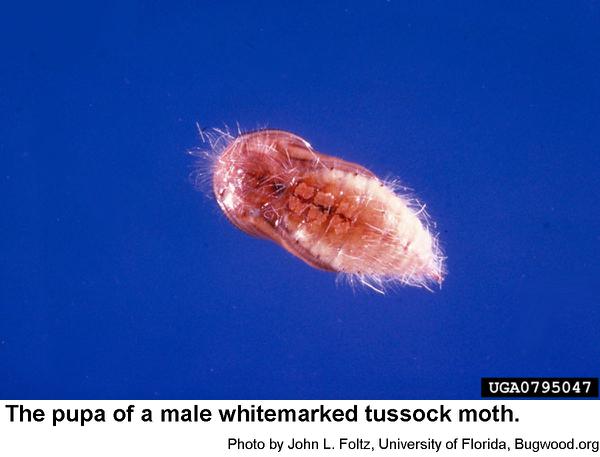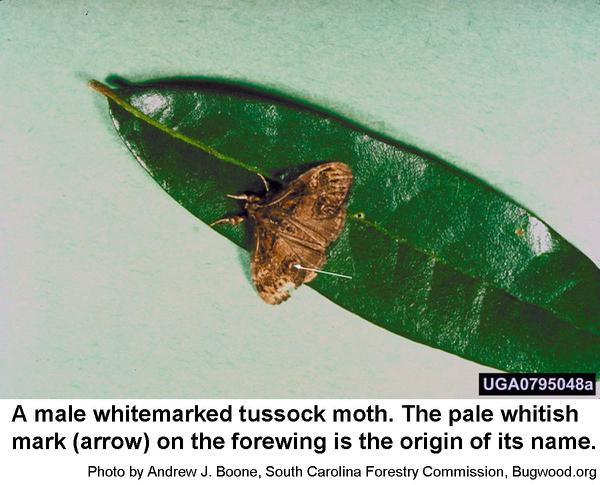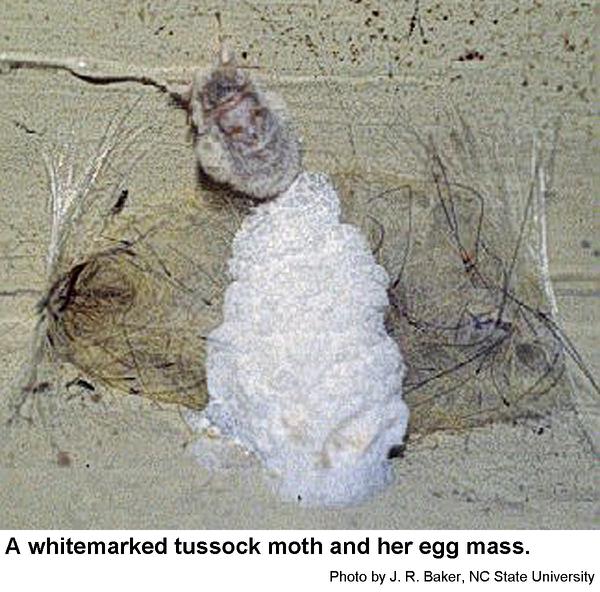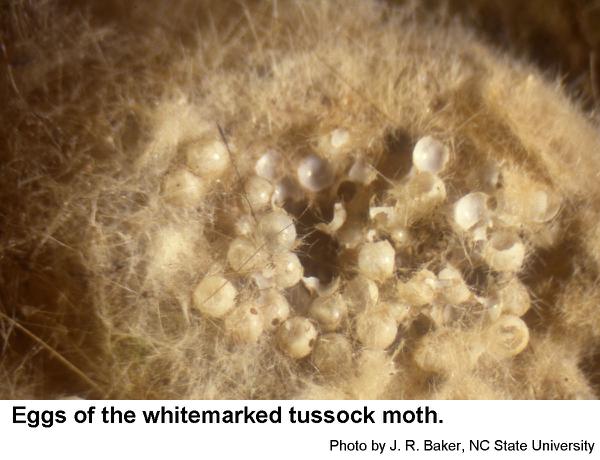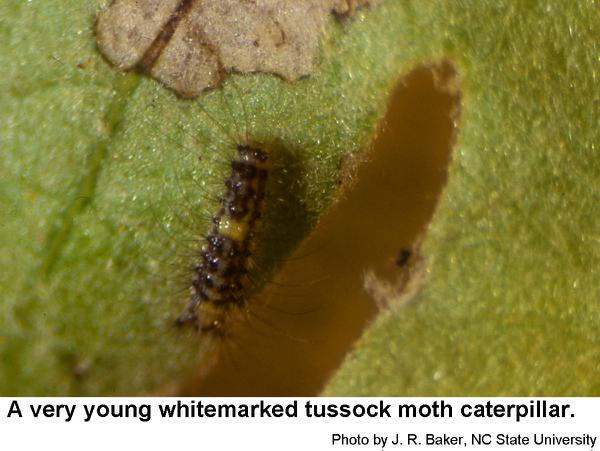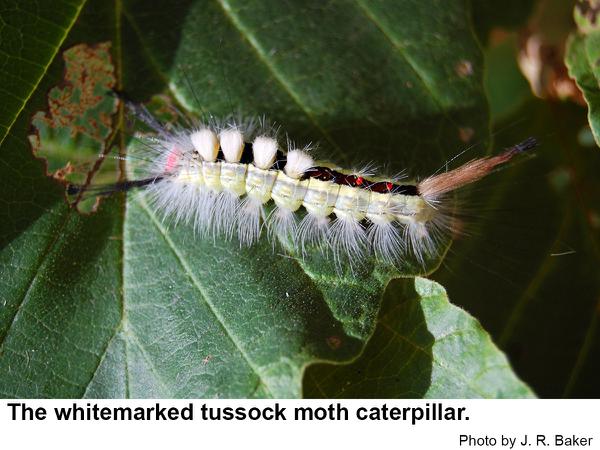Description and Biology
The whitemarked tussock moth, Orgyia leucostigma, is a native insect that for unknown reasons, may suddenly become locally abundant. This insect overwinters as eggs in a mass laid in or on the mother's cocoon. In spring, the eggs hatch and the tiny, hairy caterpillars begin to feed and grow. Some drop from trees suspended by a silk strand. These may balloon for a considerable distance to invade new landscapes. After feeding for several weeks, the caterpillars eventually grow 1 to 11/2 inches long. They have two hair "pencils" of black setae that extend forward beyond the head and a rear "pencil" of black setae at the rear. The caterpillars also have four dense white clumps of short setae on the top of the first four abdominal segments as well as two bright red bumps on segments six and seven. Some of these setae contain urticating material that can cause dermatitis on sensitive skin. When mature, the caterpillars spin grayish cocoons inside of which they pupate. Cocoons are often abundant on bark and objects nearby. Sometime whitemarked tussock moth caterpillars can be a nuisance as they crawl about looking for a suitable place to spin their cocoons. About two weeks later, the moths emerge and mate. Male moths have mottled brown to brownish gray wings that have a purplish tint when newly emerged. Females have wings that are so short the moths appear to be wingless and are gray, plump creatures that lay their eggs in a mass on the cocoon and then cover the eggs with a frothy material that hardens into a protective covering. We have two generations per year in North Carolina.
Host Plants
Oak appears to be a favorite host in North Carolina as well as cherry, hackberry, and willow. However, whitemarked tussock moth caterpillars have been reported from plants in 116 genera. Dermatitis due to the urticating setae of tussock moth caterpillars has been reported from day-care centers and elementary schools when children play with these attractive caterpillars. Contact with the cocoons can produce the same symptoms even after cocoons are a year old.
Residential Recommendations
Whitemarked tussock moth caterpillars are plagued with diseases, parasites, and predators, which may explain why they are seldom wide spread pests. By the time the caterpillars are usually noticed, they have probably finished feeding and are seeking a site to spin their cocoons. Applying a pesticide to mature, migrating caterpillars is a waste of time as they are quite tolerant of pesticides. The best time to spray is when the caterpillars are young and actively feeding. At that time even Bacillus thuringiensis formulations can give adequate control. Young caterpillars are also susceptible to pyrethroid insecticides available at most garden centers. When used as directed, pyrethroids are very toxic to insects but are not particularly hazardous to humans and pets (other than fish-avoid using pyrethroids around pools, ponds, and streams). However, it can be a challenge to safely get an insecticide up into the canopy of tall trees. Consider using the services of a professional landscaper or arborist for treating large trees.
References
- Caterpillars that Feed on Trees and Shrubs. Frank, S. D. and S. B. Bambara. 2009 (revised). Entomology Insect Notes, NC State Extension Publications
- Common name: whitemarked tussock moth, scientific name: Orgyia leucostigma (J.E. Smith, 1797) (Lepidoptera: Erebidae: Lymantriinae). Hall, D. W. and L. Buss. 2014. Featured Creatures. Entomology & Nematology, FDACS/DPI, EDIS. Publication Number: EENY-588.
- Extension Plant Pathology Publications and Factsheets
- Horticultural Science Publications
- North Carolina Agricultural Chemicals Manual
For assistance with a specific problem, contact your local Cooperative Extension Center.
This Factsheet has not been peer reviewed.
Publication date: Aug. 9, 2017
Reviewed/Revised: Oct. 26, 2019
Recommendations for the use of agricultural chemicals are included in this publication as a convenience to the reader. The use of brand names and any mention or listing of commercial products or services in this publication does not imply endorsement by NC State University or N.C. A&T State University nor discrimination against similar products or services not mentioned. Individuals who use agricultural chemicals are responsible for ensuring that the intended use complies with current regulations and conforms to the product label. Be sure to obtain current information about usage regulations and examine a current product label before applying any chemical. For assistance, contact your local N.C. Cooperative Extension county center.
N.C. Cooperative Extension prohibits discrimination and harassment regardless of age, color, disability, family and marital status, gender identity, national origin, political beliefs, race, religion, sex (including pregnancy), sexual orientation and veteran status.

